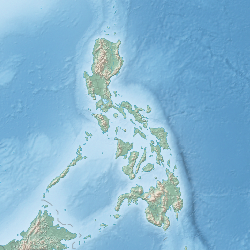帕瓦伊教堂
| 帕瓦伊教堂 | |
|---|---|
| 圣奥斯定堂区教堂 | |
| 圣奥古斯丁教堂 帕瓦伊圣奥斯定堂 | |
 | |
| 國家/地區 | 菲律宾 |
| 位置 | 北伊罗戈省帕瓦伊 |
| 坐标 | 18°3′41.5″N 120°31′17.5″E / 18.061528°N 120.521528°E |
| 所屬宗派 | 罗马天主教 |
| 歷史 | |
| 教會地位 | 堂区教堂 |
| 創建日期 | 1686年 |
| 創建者 | 安东尼奥·埃斯塔维略神父 (Padre Antonio Estavillo) |
| 奉獻 | 希波的圣奥古斯丁 |
| 建築 | |
| 功能狀態 | 使用中 |
| 文物保護地位 | 国家文化宝藏、世界文化遗产 |
| 指定時間 | 1973年、1993年 |
| 建筑师/公司 | 安东尼奥·埃斯塔维略神父 |
| 建築類型 | 教堂 |
| 建築風格 | 地震巴洛克风格 |
| 動工日期 | 1694年 |
| 竣工日期 | 1710年 |
| 詳細規格 | |
| 長度 | 110米(360英尺) |
| 寬度 | 40米(130英尺) |
| 塔数 | 1 |
| 尖塔數 | 15 |
| 建築材料 | 珊瑚石、砖块 |
| 行政 | |
| 教區 | 拉瓦格 |
| 教省 | 新塞哥维亚 |
| 官方名稱 | 圣奥古斯丁教堂(帕瓦伊) |
| 隸屬 | 菲律宾的巴洛克教堂 |
| 標準 | 文化:(ii)(iv) |
| 参考编码 | 677bis-003 |
| 登录年份 | 1993年(第17次會議) |
| 扩展年份 | 2013年 |
| 官方名称 | 帕瓦伊教堂 |
| 類型 | 宗教建筑 |
| 评定时间 | 1973年8月1日[1] |
| 法律依据 | PD No. 260, s. 1973 |
| 大区 | 伊罗戈区 |
| 标记日期 | 1980年5月2日 |
| 地圖 | |
 | |
圣奥斯定堂区教堂(英語:Saint Augustine Parish Church)或圣奥古斯丁教堂,通称帕瓦伊教堂(Paoay Church),是位于菲律宾北伊罗戈省帕瓦伊市镇的罗马天主教教堂,隶属于天主教拉瓦格教区。教堂于1710年落成,以其独特的建筑风格闻名,侧面与后方筑有巨型扶壁。
1973年,该教堂被菲律宾政府认定为国家文化宝藏;1993年,作为“菲律宾的巴洛克教堂”的一部分,入选联合国教科文组织列为世界文化遗产。
历史
[编辑]该地区最早的历史记载可追溯至1593年,1686年成为独立的奥斯定会堂区[2]。现存教堂由奥斯定会修士安东尼奥·埃斯塔维略神父于1694年主持兴建,1710年完工,1896年重新祝圣[3][4]。
教堂在1865年与1885年地震中部分损毁,后经前第一夫人伊梅尔达·马科斯推动修复。[5]
修复工程
[编辑]
出于对建筑结构完整性的担忧,政府与非政府组织曾多次推动帕瓦伊教堂修复计划。2014年,北伊罗戈省政府通过决议,要求对教堂进行结构加固,并重建已成废墟的修道院建筑。[3][6]
2018年,官方宣布将对教堂的扶壁、墙体、钟楼及内部空间开展系统性修复[7]。菲律宾国家历史委员会于2019年启动教堂外部修缮工程,2020年6月完工。工程重点修复具有历史价值的石砌墙与扶壁,清除外墙植被以防止石材侵蚀与石灰浆流失,并对钟楼楼梯进行了结构性修缮,同时全面翻新屋顶系统。[8]
2020年11月,修复完成的建筑正式移交拉瓦格教区,当月15日重新开放。[9]
建筑特色
[编辑]帕瓦伊教堂被誉为菲律宾西班牙殖民时期地震巴洛克风格建筑的典范。学者艾丽西亚·科塞滕(Alicia Coseteng)提出[4],地震巴洛克是對欧洲巴洛克风格的本土化演绎,藉由运用巨型侧翼与后殿扶壁以适应菲律宾频发的地质活动[3]。这种基于抗震需求的巴洛克风格适应性改造,源于该国早期教堂多次被破坏性地震摧毁的经验。此外,教堂墙面与立面装饰中亦可见爪哇婆罗浮屠建筑风格的影响。[3]
扶壁
[编辑]
帕瓦伊教堂最引人注目的特征是其24座巨型扶壁[10],这些侧后方扶壁厚度达约1.67米(5.5英尺)[5]。从外墙延伸而出的设计,是为抵御潜在地震破坏而提出的创新解决方案。教堂侧面的阶梯式扶壁(stair-like buttresses;step buttresses)可能兼具通往屋顶的通道功能。[4]
墙体
[编辑]教堂墙体下部以巨型珊瑚石砌筑,上层则采用砖材[4]。建筑所用的砂浆由沙子、石灰混合制成,其中掺入经芒果叶、皮革及稻草共同熬煮的甘蔗汁[4]。墙面纹饰展现出爪哇建筑风格特征[11]。
立面
[编辑]
石质立面以拔地而起的巨型三角楣为特征,整体构造向前倾斜。方形壁柱与层叠的檐口分别构成纵横分割线。立面底部保持素面处理,顶部装饰融合哥特式尖顶与中式纹样,三角楣彰显东方笔触。[10][12]立面还可见城垛、壁龛、蔷薇纹及奥斯定会徽等元素[4]。其下层为砖砌结构,上层则由珊瑚石构筑[13]。
钟楼
[编辑]
与主殿分离的三层珊瑚石钟楼位于立面右侧,形制近似塔[4][12]。钟楼奠基石于1793年安放[5],其独立式结构兼具抗震考量[13]。在1898年反抗西班牙统治与二战期间抵御日军的斗争中,此建筑曾先后作为革命者与游击队的观测点[10][14]。据史料记载,钟楼亦是当地社会地位的象征——名门望族举办婚礼时,钟声往往鸣响得更为洪亮持久[15]。
图集
[编辑]指定保护
[编辑]
根据第260号总统法令,帕瓦伊教堂于1973年被菲律宾政府指定为国家文化宝藏[1]。1993年12月11日,该教堂与马尼拉圣奥斯定堂、南伊罗戈省圣玛丽亚的圣母升天堂以及伊洛伊洛省米亚高的圣托马斯·德比利亚努埃瓦堂共同被列入联合国教科文组织世界遗产名录[13]。
相关条目
[编辑]参考资料
[编辑]- ^ 1.0 1.1 ((Presidential Decree No. 260)), Declaring the Sta. Ana Site Museum in Manila, the Roman Catholic Churches of Paoay and Bacarra in Ilocos Norte, the San Agustin Church and Liturgical Objects Therein in Intramuros, Manila, Fort Pilar in Zamboanga City, the Petroglyphs of the Rock-shelter in Angono, Rizal, the Petroglyphs of Alab, Bontoc, the Stone Agricultural Calendars of Dap-ay Guiday in Besao, Bontoc, the Mummy Caves of Kabayan, Benguet and of Sagada and Alab, Bontoc, the Ifugao Rice Terraces of Banaue as National Cultural Treasures; and the Barasoain Church in Malolos, Bulacan, Tirad Pass in Cervantes, Ilocos Sur, the Miagao Church in Miagao, Iloilo, the Site of the Battle of Mactan on Mactan Island, Cebu, the San Sebastian Church in Quiapo, Manila, and the Church and Convent of Santo Niño in Cebu City as National Shrines, Monuments, and/ or Landmarks, Defining the Implementing Agencies and Providing Funds Therefor, The Official Gazette, 1 August 1973 [2024-09-14] (英语)
- ^ Heritage Conservation Society. "Paoay Church". 2006-07-27 [2011-07-09]. (原始内容存档于2022-09-11) (英语).
- ^ 3.0 3.1 3.2 3.3 Lazaro, Freddie. Retrofitting of Paoay church sought. Manila Bulletin. 2014-06-28 [2014-09-19]. (原始内容存档于2014-10-18) (英语).
- ^ 4.0 4.1 4.2 4.3 4.4 4.5 4.6 Gaspar, Roger. Earthquake Baroque: Paoay Church in the Ilocos. 1996 [2014-09-19]. (原始内容存档于2008-11-02) (英语).
- ^ 5.0 5.1 5.2 Bagaforo, Nelson. Historic churches of Ilocos Norte. Sun.Star. 2011-04-20 [2014-09-20]. (原始内容存档于2014-10-14) (英语).
- ^ Restoration of Paoay church pushed. The Philippine Star. 2014-06-23 [2014-09-19]. (原始内容存档于2022-06-25) (英语).
- ^ Adriano, Leilanie. NHCP to restore historic Paoay Church, Bacarra Tower in Ilocos. Philippine News Agency. 2018-12-11 [2022-08-06]. (原始内容存档于2022-08-06) (英语).
- ^ Magcamit, Yann. This UNESCO heritage site just got restored, and now you can visit it via video. Nolisoli. 2020-06-22. (原始内容存档于2022-06-15) (英语).
- ^ Tabios, Hanah. NHCP delivers restored heritage icons to Ilocos Norte. Manila Bulletin. 2020-11-19 [2022-08-06]. (原始内容存档于2020-12-02) (英语).
- ^ 10.0 10.1 10.2 Aquino, Mike. Touring the oldest churches in the Philippines. Yahoo News Philippines. 2013-05-15 [2014-09-20]. (原始内容存档于2021-11-08) (英语).
- ^ The Paoay Church: Ilocos Norte, Philippines. digitaljournal.com. [2018-11-21]. (原始内容存档于2018-11-21) (英语).
- ^ 12.0 12.1 Villalon, Augusto. 16th to 19th Century Church Architecture in the Philippines. National Commission for Culture and the Arts. [2014-09-20]. (原始内容存档于2015-04-28) (英语).
- ^ 13.0 13.1 13.2 Baroque Churches of the Philippines. UNESCO World Heritage Site. [2014-06-25]. (原始内容存档于2022-09-01) (英语).
- ^ Paoay church in Ilocos to get facelift. Balita.ph. 2011-03-16 [2014-09-20]. (原始内容存档于2015-01-01) (英语).
- ^ St. Augustine Church in Paoay. vigattintourism.com. [2018-10-15]. (原始内容存档于2018-10-15) (英语).





